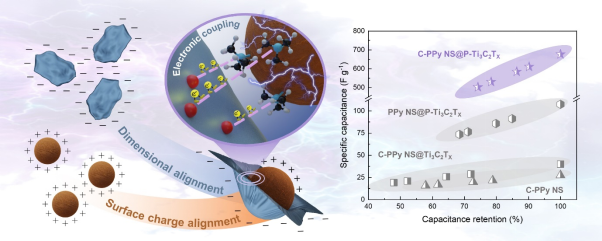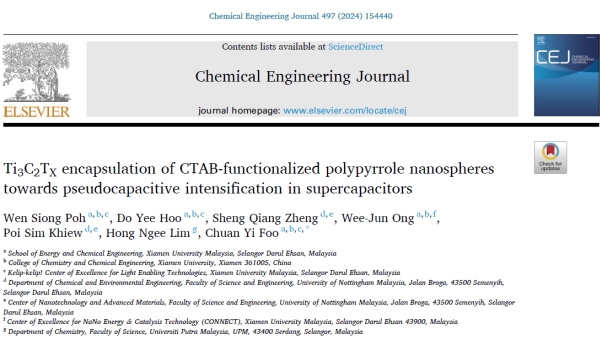In the realm of new energy, while energy harvesting technologies like solar, wind, hydro, and triboelectricity play crucial roles in addressing the global energy crisis, energy storage systems (ESSs) are equally important in preserving and efficiently distributing harvested energy to minimize wastage. Supercapacitors, with their simple production process, low safety risks, and excellent longevity, are promising ESSs, especially in line with the trend of portable electronic devices.
Recently, a group of researchers from Xiamen University Malaysia (XMUM) explored the potential of methodical active material design to develop a supercapacitor with enhanced specific capacitance (energy storage capacity) without compromising rate performance (energy release speed). The team includes Master’s students Poh Wen Siong (New Energy Science and Engineering) and Hoo Do Yee (Chemical Engineering), alongside Dr. Braedan Foo Chuan Yi and Prof. Ong Wee Jun from the School of Energy and Chemical Engineering.
Their work, titled “Ti3C2TX Encapsulation of CTAB-Functionalized Polypyrrole Nanospheres Towards Pseudocapacitive Intensification in Supercapacitors,” was published in the Chemical Engineering Journal, a Q1 SCI journal with an impact factor of 13.3.
A decade-long dilemma in supercapacitor technologies is the trade-off between specific capacitance and rate performance. In this work, the team delved into the synthesis design of a nanocomposite that integrates nanomaterials of polypyrrole nanospheres (PPy NS) and MXene (Ti3C2TX) nanoflakes. By combining surface charge and dimensional alignment techniques, the nanocomposite attained remarkable specific capacitance and rate performance. This was made possible via precise enwrapping of PPy NS by highly conductive Ti3C2TX nanoflakes and an electronic coupling mechanism induced by surface functionalization of PPy NS.

Synthesis design of PPy/Ti3C2TX nanocomposite combines strategies of dimensional and surface charge alignment to facilitate individual encapsulation PPy NS by Ti3C2TX nanoflakes and realize electronic coupling, yielding synergistic augmentation in specific capacitance and rate performance.
This research is supported by the Fundamental Research Grant Scheme by Ministry of Higher Education Malaysia (FRGS/1/2021/STG04/XMU/02/1 and FRGS/1/2022/TK09/XMU/03/2), and the Xiamen University Malaysia Research Fund (XMUMRF/2023-C11/ IENG/0056).

The article can be accessed at https://doi.org/10.1016/j.cej.2024.154440

Poh Wen Siong: “This research journey is truly an eye-opening experience, challenging yet fruitful. While it is gratifying being able to contribute my findings on active material designing strategies for supercapacitors, it is also humbling to witness and understand the vast advanced global research efforts devoted to transcend the capabilities of ESS technologies.”

Hoo Do Yee: “I was intrigued when I first encountered this topic during Wen Siong’s award-winning presentation at the 5-Minute Research Presentation Competition in 2021. Since then, it has been an honour and a privilege to be involved in developing an advanced MXene/Polypyrrole nanocomposite for energy storage and to see our collaborative efforts result in a successful publication.”

Dr. Ong Wee-Jun received his BE and PhD in Chemical Engineering from Monash University. He is a Professor and the Assistant Dean at School of Energy and Chemical Engineering, Xiamen University Malaysia, as well as the Director of Center of Excellence for NaNo Energy & Catalysis Technology (CONNECT). His research interests include nanomaterials for energy storage devices, photocatalytic, photoelectrocatalytic, and electrochemical H2O splitting, CO2 reduction and N2 fixation.

Now an Assistant Professor in New Energy Science and Engineering at Xiamen University Malaysia, Dr. Braedan Foo Chuan Yi received his BSc and PhD from Universiti Putra Malaysia (2015 and 2018, respectively). He is particularly interested in unravelling the potential and workability of advanced manufacturing technology in nanomaterials fabrication, as well as improving the performance of current electrochemical energy storage devices.